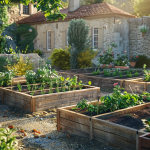Transform your garden into a flourishing oasis with raised garden beds. Discover the essentials to build your own: from selecting quality timber and tools, to step-by-step construction techniques. Learn how raised beds enhance soil quality, provide better accessibility, and add visual appeal. Explore innovative design ideas and find tips on planning an efficient and stunning garden layout. Let’s elevate your gardening experience to new heights!
Creating raised garden beds: step-by-step guide
Creating raised beds is an excellent way of improving soil management and making your garden easier to maintain. For a high-quality option, explore https://bacsac.com/gb/shop/65-raised-garden-beds.html.
A lire aussi : How to Calibrate the Adaptive Front Lighting System on an Audi Q5 for Perfect Road Illumination?
materials and tools needed
To build a raised garden bed, start with durable timber such as softwood sleepers or reclaimed hardwood. Gather essential tools including a spirit level, heavy-duty coach screws, and a measuring tape. Ensure you have a saw for cutting timber to size and a cordless drill for securing screws. Protective clothing is recommended, especially if using materials like railway sleepers, which may contain harmful substances.
Construction process
Begin by marking the bed’s shape using canes and string. Dig a shallow trench where the bed will sit. Place the first layer of timber in the trench, ensuring it is level using a spirit level. Secure the timbers together with coach screws. For added strength, overlap joints and reinforce the structure with vertical batons.
A lire également : Can Upgrading to a Racing-Grade Timing Belt Benefit Your Mitsubishi Eclipse’s Engine Longevity?
Adding layers and securing
After the initial layer, prepare the base by removing turf and forking over the soil. Fill the bed to about 5 cm below the rim and allow it to settle for a few weeks. For deeper beds, add multiple layers of timber, again ensuring each layer is level and securely fastened. This step-by-step process ensures a sturdy and functional raised garden bed, ready for planting.
Benefits and design ideas for raised garden beds
One of the primary benefits of raised garden beds is the improved soil quality. By controlling the soil mix, you can ensure optimal conditions for various plants, including vegetables, fruits, and herbs. Raised beds are also more accessible, making gardening easier for those with limited mobility.
For raised garden bed design, consider adding trellises for climbing plants like tomatoes and cucumbers. Incorporating benches or seating areas can enhance both functionality and aesthetic appeal. To maximize space, opt for vertical gardening solutions or tiered beds, which are particularly useful in small gardens.
When planning a raised bed, efficient layout is crucial. Group plants with similar water and sunlight needs together. For instance, place sun-loving vegetables like tomatoes and peppers in the same section. To further optimize your vegetable garden planning, incorporate companion planting techniques, which can boost productivity and deter pests.
Choosing the right raised garden bed products
When choosing raised garden bed products, consider raised garden bed kits and custom raised garden beds. Kits are ideal for beginners, offering convenience and ease of assembly.
BACSAC raised garden beds feature permeable fabric, allowing soil to breathe and excess water to drain. The fabric also protects roots, reduces evaporation, and distributes water evenly.
These beds are especially beneficial for urban and small-space gardening. Their lightweight and flexible structure make them suitable for balconies or patios, optimizing limited spaces. Additionally, BACSAC’s designs are rooted in permaculture principles, making them an eco-friendly choice.
Choosing the right materials and designs, such as those from BACSAC, ensures your garden bed will be both functional and sustainable.






